Do you need to move out of your rental for a job or to go to school? Is your family expanding, or do you need to cut down on some of your bills to downsize? When you are in the middle of your lease, it may seem like you are stuck and can’t get out of the agreement. But an assignment of lease can be the trick you need to get ahead.
What is Assignment of Lease?
It is a tool that a tenant can utilize if they wish to get out of their lease ahead of time and assign it to another tenant.
Not all landlords will allow this, and if they do, they often have specific rules about how it can occur. When the landlord allows it, the tenant can move out of the rental and not worry about the penalties of breaking their lease.
Different names are used for an assignment of lease. Some of these include:
- Lease transfer
- Assignment agreement
- Lease assignment agreement
- Lease assignment form
No matter the name it goes under, it will serve the same purpose. This agreement will be useful to a tenant who wishes to leave the rental property ahead of the end of the lease. If they want to leave after six months and the lease is for one year, they may need to do a lease assignment with their landlord to help fill the rental before leaving.
This will help them solve this problem. With the permission of the landlord, the tenant can transfer their obligation under the lease over to another person. Once the landlord agrees , the new tenant (assignor) can move in and follow the same rules that the original tenant (assignee) did, including property maintenance and any rent obligations. This will then release them from the obligations under the lease, allowing them to move and sign a new lease without a bad recommendation.
Most states require the landlord to be reasonable when it comes to a lease assignment. They do not have to accept each person you bring to them, especially if that person has a bad rental payment history or another problem that the landlord would not usually tolerate in their properties. But the landlord is not allowed to make things unnecessarily difficult, and they can’t refuse a tenant only to keep you on the property.
Both parties must have sufficient paperwork to help keep things organized. This should start with a properly drafted assignment so that all parties, including the landlord, new tenant, and old tenant, can understand which obligations are being transferred and who will be part of the new lease. This agreement can make the new tenant and landlord relationship run smoothly.
Types of Lease Assignment
The type of lease assignment the tenant will sign depends on the type of lease agreement the tenant has from the start. They may live in a residential home and need to do a lease assignment that works for that, or they could be a major business that will need assignment to leave the commercial property.
Residential lease assignment
When a tenant lives in an apartment, duplex, single-family home, or another place that they call home and need to move out before the end of the lease, they can do an assignment of lease. This allows them to find another tenant for the landlord, someone who will take their place and continue with the terms of the lease.
When the original tenant chooses to do a lease assignment, they will contact their landlord. The landlord can then screen the tenant to make sure their background, credit, and past rental history match up with who the landlord is comfortable renting out to. After these checks are done, the landlord can write the assignment and sign it with both the original and new tenant before the new agreement begins.
Commercial lease assignment
Some leases are between landlords and commercial businesses. The business utilizes the building in order to run their day to day operation. The business may decide that they no longer want to rent that property in the middle of their lease. The business can use the lease assignment form to help them get out of the lease with a new business in their place.
Assignment Vs. Sublease
Some tenants may be confused about the differences between a sublease and a lease assignment. Both of these will involve the original tenant finding someone new to take over the property, but they are different processes. If the tenant wants to do an assignment of lease, they need to do it the proper way to make sure it is done the right way.
The assignment will occur when the tenant works with the landlord to transfer their lease over to a new tenant. The new tenant must agree to take over the lease, keeping the property maintained and paying the rental amount each month. The previous tenant will no longer have their name on the lease and is free to move on to a new property without having to keep up with the obligations of the lease. The landlord will be part of this agreement as they do screenings and need to approve the new tenant.
The sublease will be when the tenant chooses to hand over the obligations of the lease to someone else through a subleasing agreement. The landlord is not part of this agreement, and they often do not approve of subleasing because it can allow an unknown person into the property without the landlord’s approval. The tenant will be held responsible for the original lease and all of its terms, so it can be a risky thing to work on.
You must look through the original lease agreement to see what rules are in place for subleasing or doing an assignment of lease. Most lease agreements will include whether one or both of these are allowed and will list out the specific steps that the tenant must follow for both of them.
What to Include
Each lease assignment will be a little different, and it may depend on the unique components that were in the original lease from the start.
Some of the items that you should include in your document include the following:
Type of lease
List out details about the type of lease that this letter should concern. The type of lease is usually either commercial or residential.
Location of property
Write out the physical location or complete address of the property to make sure there is no confusion in understanding the document. Make sure that the address includes the city name, the state, and the zip code along with it.
Parties’ details
There are three parties who will agree to the assignment of lease, including the landlord, the assignor or the original tenant, and the assignee or the proposed new tenant. Include relevant details about each individual, including their names and addresses.
Original lease term
The original tenant will need to include the terms of the original lease. They can pull out the lease and include information like the start and the end dates of that lease. The landlord could look these up, but it is helpful to have them in place to avoid confusion.
Start date of the lease transfer
Everyone should agree on the date that the lease transfer will occur. This will be the date that the current tenant need to be out of the property, and the new tenant will take over. Most leases will stipulate a certain amount of notice for the landlord, with 30-days being the standard. So make sure there is enough time for all parties involved to get ready for the change in the lease.
Assignor’s continuing liability
The lease assignment needs to list out the amount of liability the original tenant will have for the property and the lease when they move out. This will point out whether the assignor is still liable to the landlord after the lease is assigned.
Lead paint disclosure
Lead paint disclosure is only required in certain areas, but if it is, then the disclosure will also need to be included in the lease assignment.
This assignment also needs to have a copy of the master lease, or the original lease that the assignor and landlord worked on together. A copy needs to be given to the new tenant, so they understand the rules and obligations of moving into the rental.
Free Forms
Given below are lease templates:
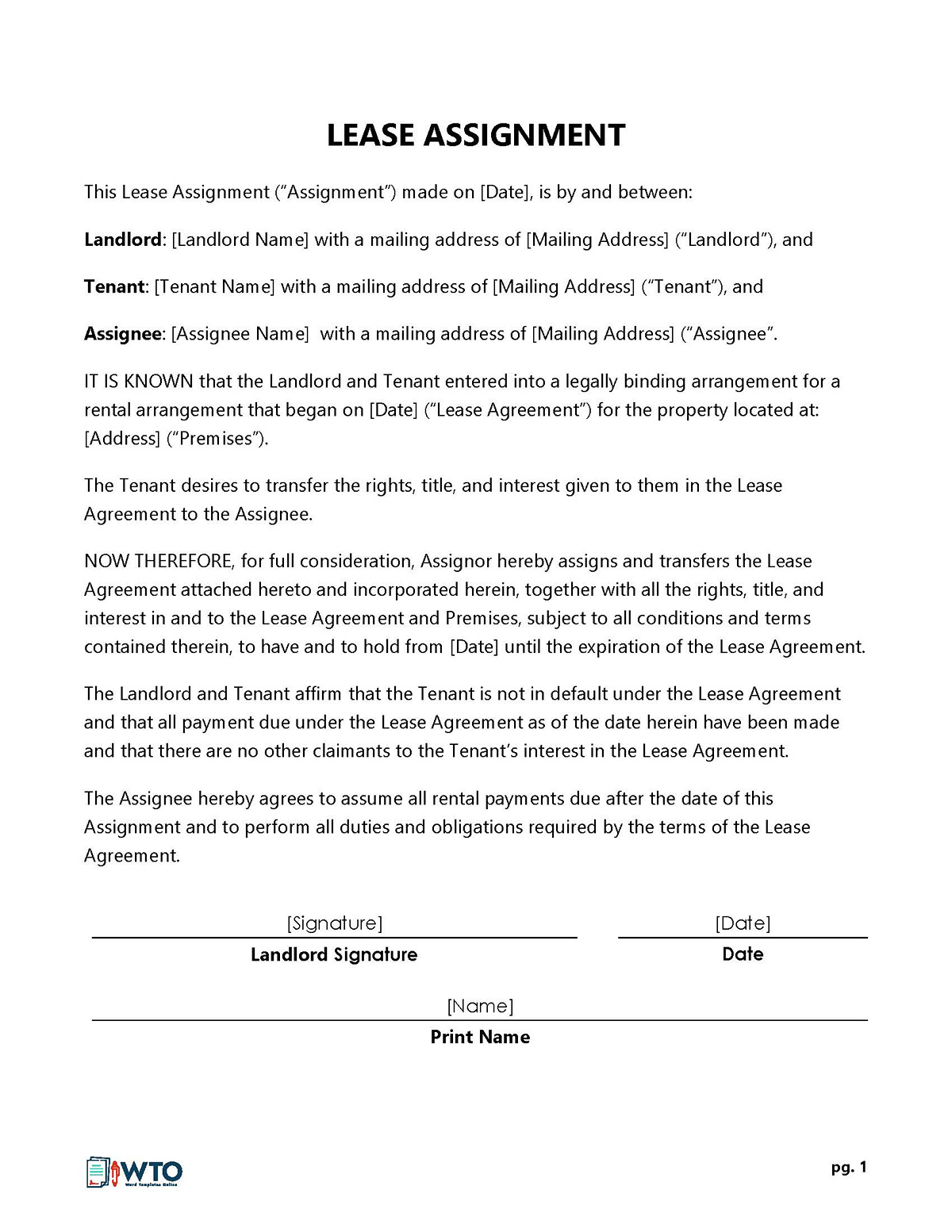
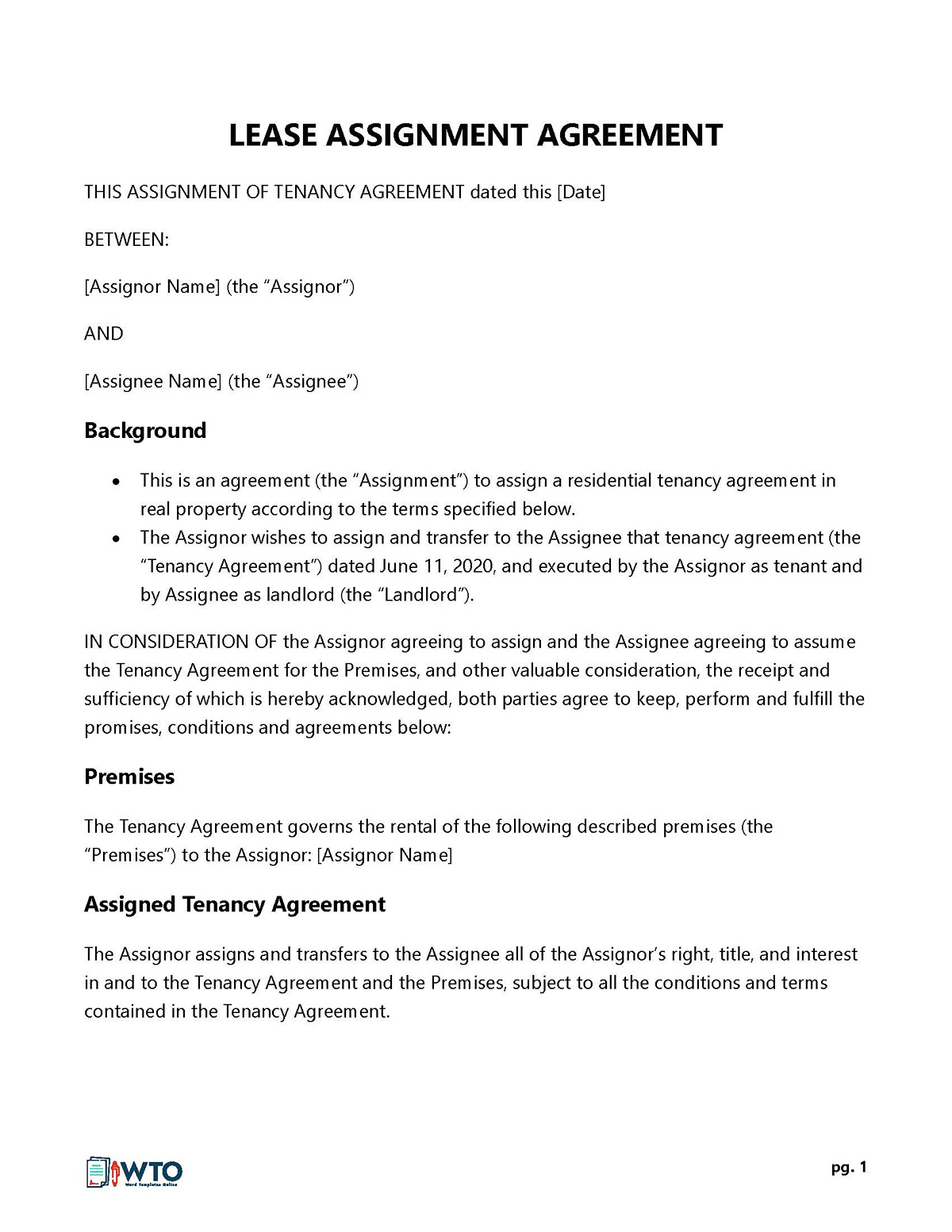
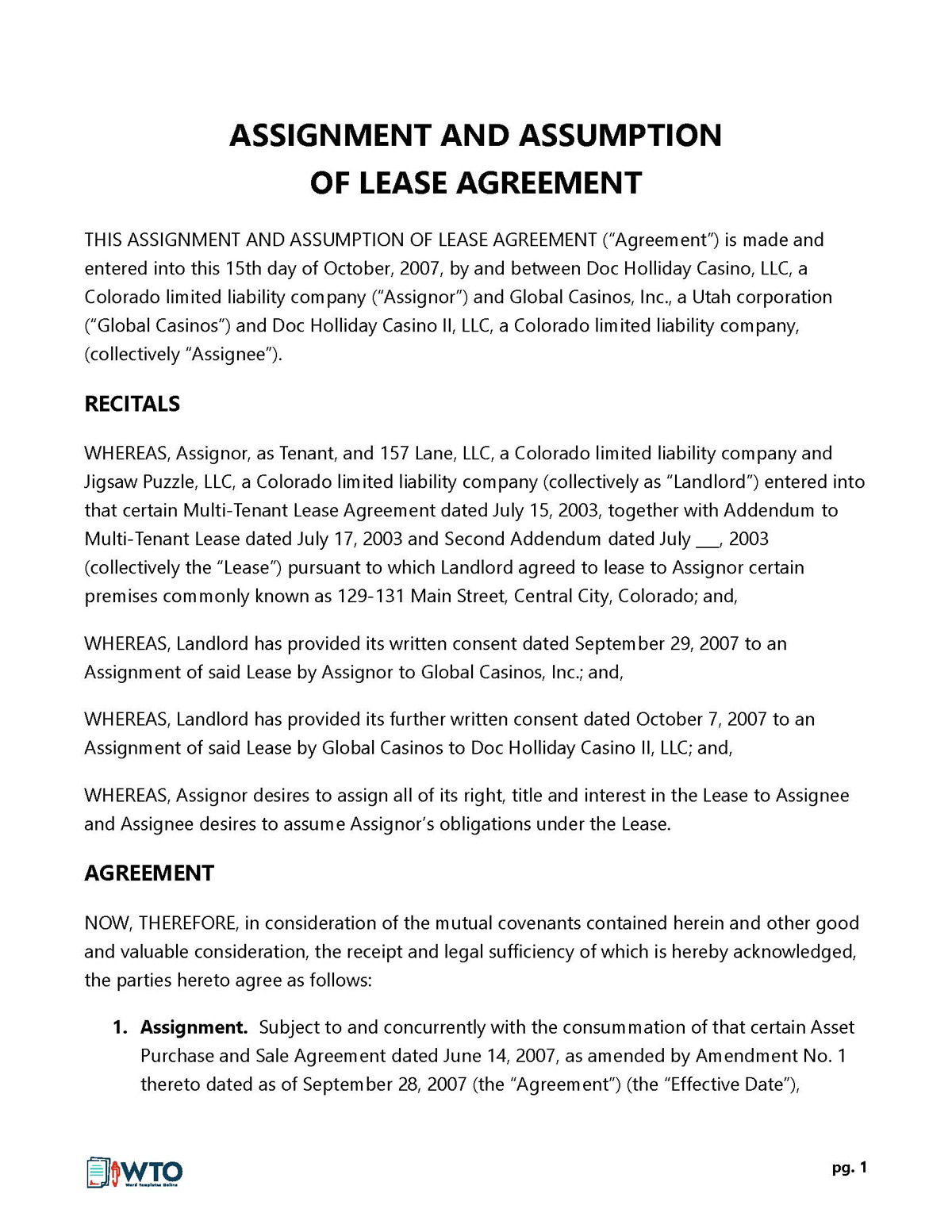
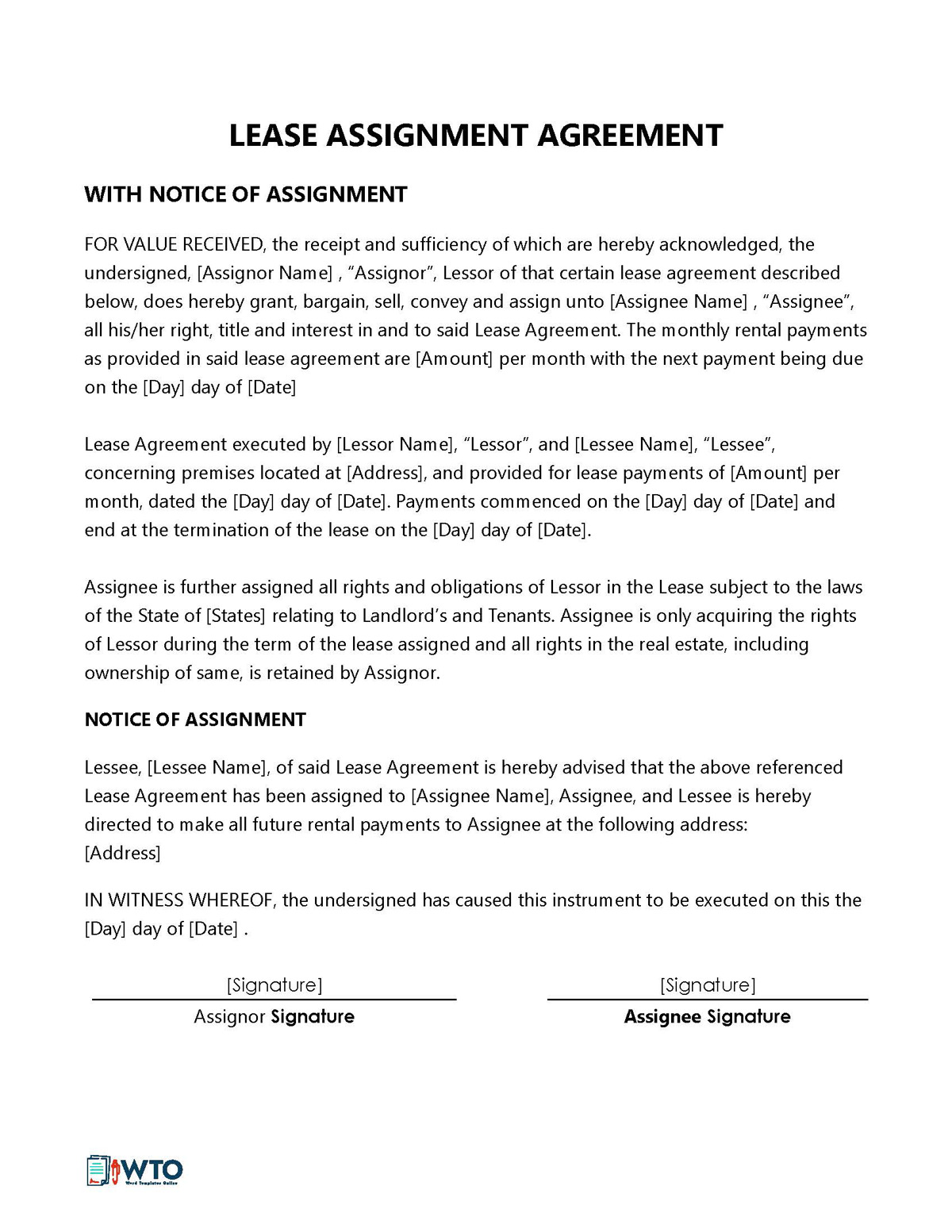
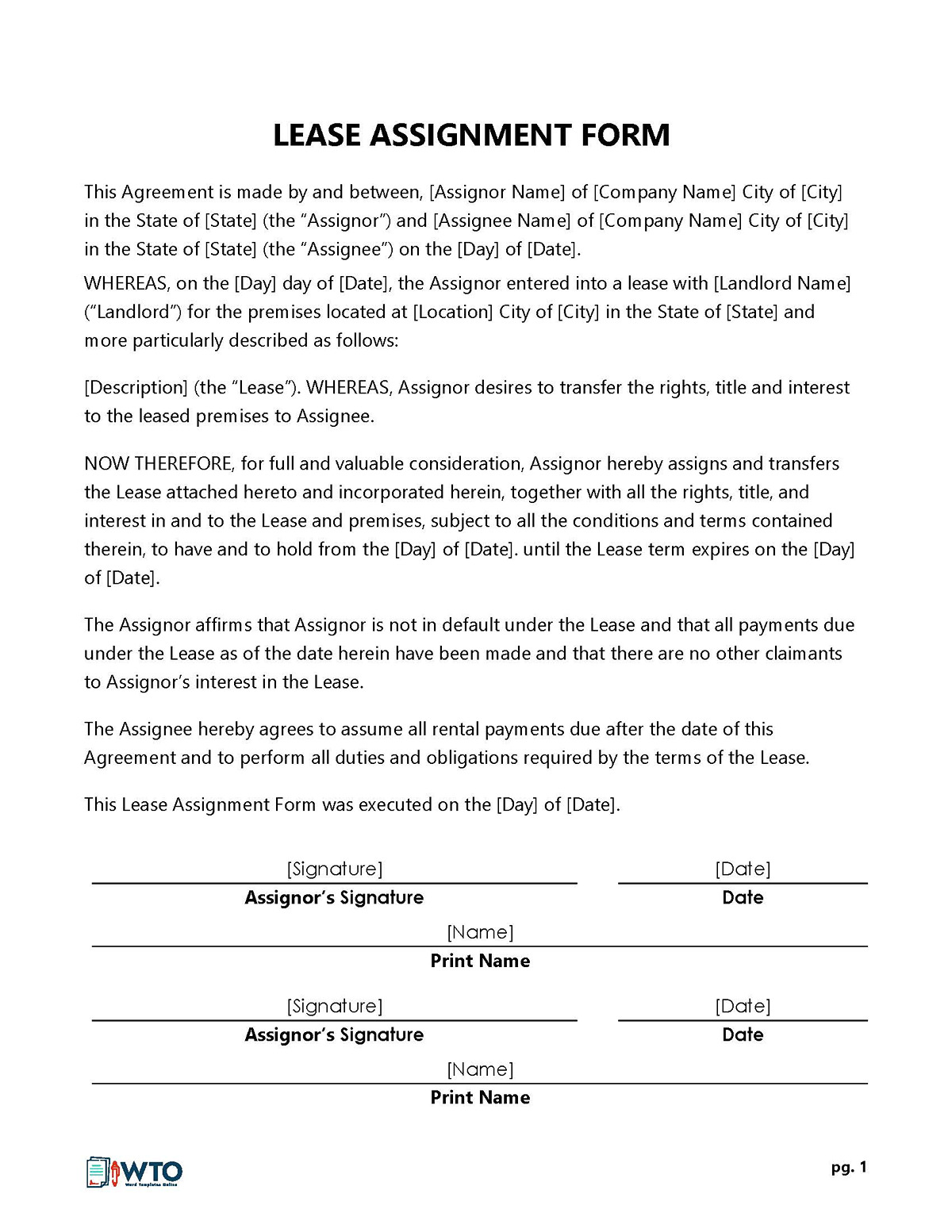
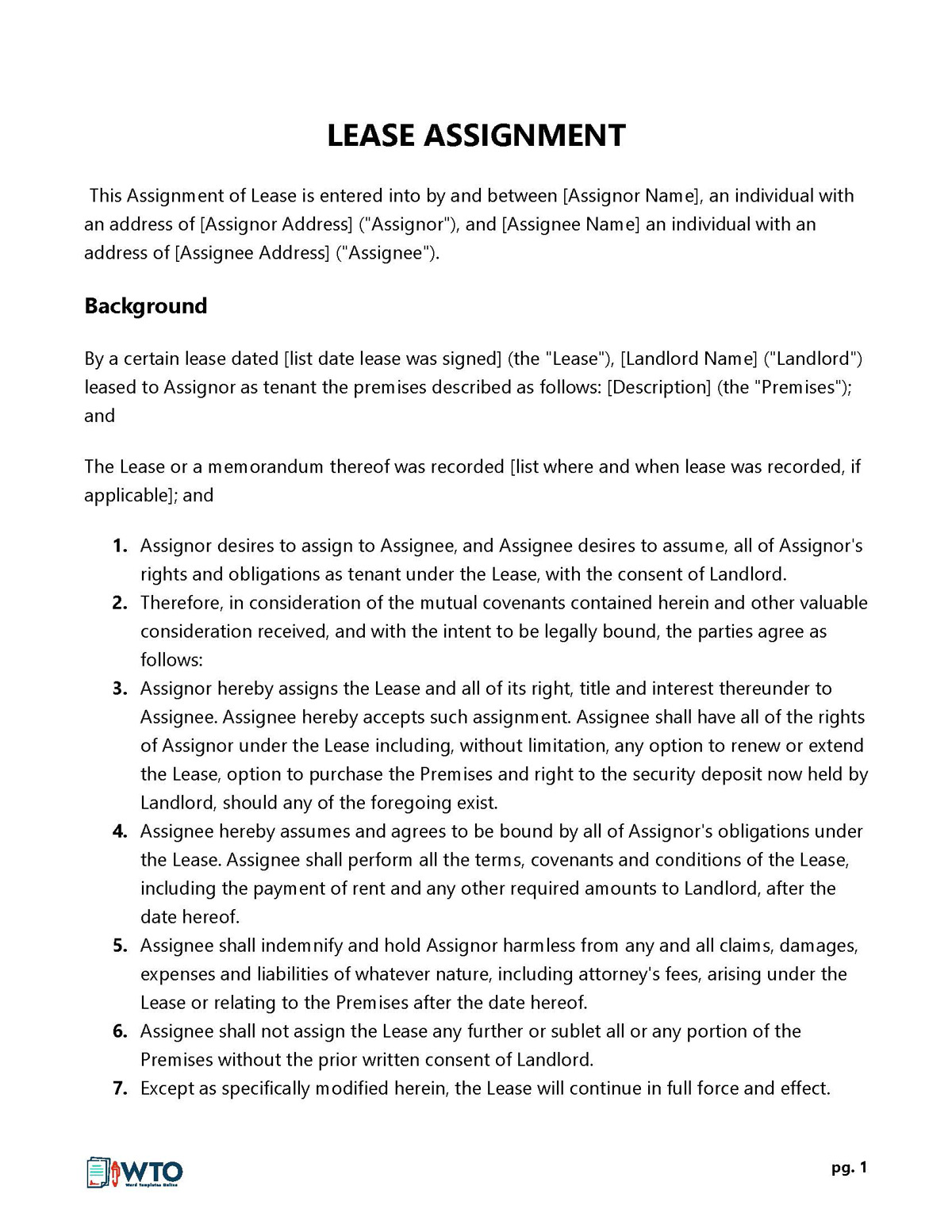
Who is Liable in an Assigned Lease?
When the original tenant is looking to do an assignment of lease so they can move out, they need to take a look at who is liable. The original master lease will often give some clues about who will be liable here. If this is not listed out in the master lease, then the landlord will get to decide whether it is the original tenant or the new tenant who will be liable for the property.
The lease assignment can help to tell who is liable here. Make sure to list out the specific situations when the assignor or the assignee will be the ones responsible for property damages, fines for non-compliance, or missed rental payments. If the assignor has been legally released from this kind of liability, the landlord will not be able to come back at them later on for repayment or damages to the property.
It is possible that the assigner will be liable, even after they leave the property and do the assignment of the lease. In this situation, the landlord can get payments from the assignor if the assignee does not make payments on time or damages the property. Utilizing the assignment agreement can help make things safe. This can be done through a release from liability.
Many landlords do not want to release the assignor from their liability. This protects the landlord more because they get the chance to go after two people, rather than one, to help with late payments or damages. The tenant will need to understand the laws and regulations in their state and add in clauses to the assigned lease to help figure out whether they can excuse themselves from liability when they move out.
Even with a release from liability or a clause that releases the tenant if there is a change in ownership of the property, there are certain expenses that the original tenant may still be responsible for. Therefore, the assignor needs to be very careful about the assignee they choose for the property to ensure that they won’t have any large, unexpected fees to deal with later.
Important Considerations
There are a few things that the assignor needs to consider before they decide to write out an assignment for the lease.
Some of the things to consider include:
Get legal assistance from a professional
Before you write out an assignment of lease, you should consider talking to a lawyer who specializes in real estate or contracts in general. They will make sure that your letter is written legally and follows the rules of your lease. It is possible that the landlord will not be open to this agreement, but the real estate lawyer can help you see whether there are other options available. With the help of a real estate lawyer, you will be able to work with them to make sure the legal language protects the assignor and that the landlord will accept the agreement.
Give assignee a copy of the original lease
The asignee needs to receive a copy of the original lease to look over before they agree to the lease assignment. This helps them see the terms of the lease, the amount they owe each month, and any other requirements they must follow if they take over the lease. Therefore, attaching the master lease to your new lease assignment is necessary.
Review your local and state laws
Each area is a little different in terms of the rules you need to follow for your assignment of lease. In some areas, you may need to notarize the assignment of the lease or have witnesses when you sign, or it will not be legal. Having these witnesses will make it take a little more time, but will help prevent challenges to the validity of the document later.
The local and regional laws on renting, leasing, and real estate will vary, and the exact ones will tell you what can be included in the assignment and what your own legal obligations are. Even the language that you include or keep out of the lease assignment will vary based on where you live. So always look up the real estate laws in your area or work with a professional to make sure you do this right.
Is a Landlord’s Consent Required for a Lease Assignment?
As you take a look through your master lease, you will usually find a clause that states any lease assignments need to have the landlord’s written consent before they become effective. The landlord may also list other requirements that the tenant needs to follow in order to have a valid transfer of the terms of the original lease. You must follow the instructions in the original lease before proceeding with the assignment of the lease to make sure that the landlord will not fight it later.
You can’t have someone move into the apartment without telling your landlord. This can be a breach of the lease and can land you in some legal trouble. It is important to have the consent of the landlord. The landlord is not able to unreasonably withhold permission for this either. As long as you choose a good tenant to replace you (one who can pass the background and income check of the landlord), most landlords will agree to this, unless the exact terms of the original lease say it is not allowed.
In some jurisdictions, the landlord may consent to the change by not responding. If they do not respond to your assignment of lease by a certain date, the assignor is allowed to consider that consent and can proceed with the transfer, them moving out of the rental and the new tenant moving in. The assignor should check their local laws to see whether this applies to them or not.
If the landlord decides that they will not accept your assignment of lease, then ask for the reasons in writing. The landlord may not withhold consent based on the race or sex of your assignee, but they can refuse if the assignee has an eviction history or does not make enough income to pay the rent on that property.
Final Thoughts
There are different reasons why a tenant will need to leave their rental before the end of the lease, and they want a way to get out of it without breaking the terms of their lease or having larger fees imposed upon them. An assignment of lease is a great way to help with this. When approved, the landlord agrees to let the assignor put an assignee into the property, someone who will take over the lease and finish it out. By understanding a lease assignment, you could help keep the landlord happy while being able to move on to the next chapter of your life.




